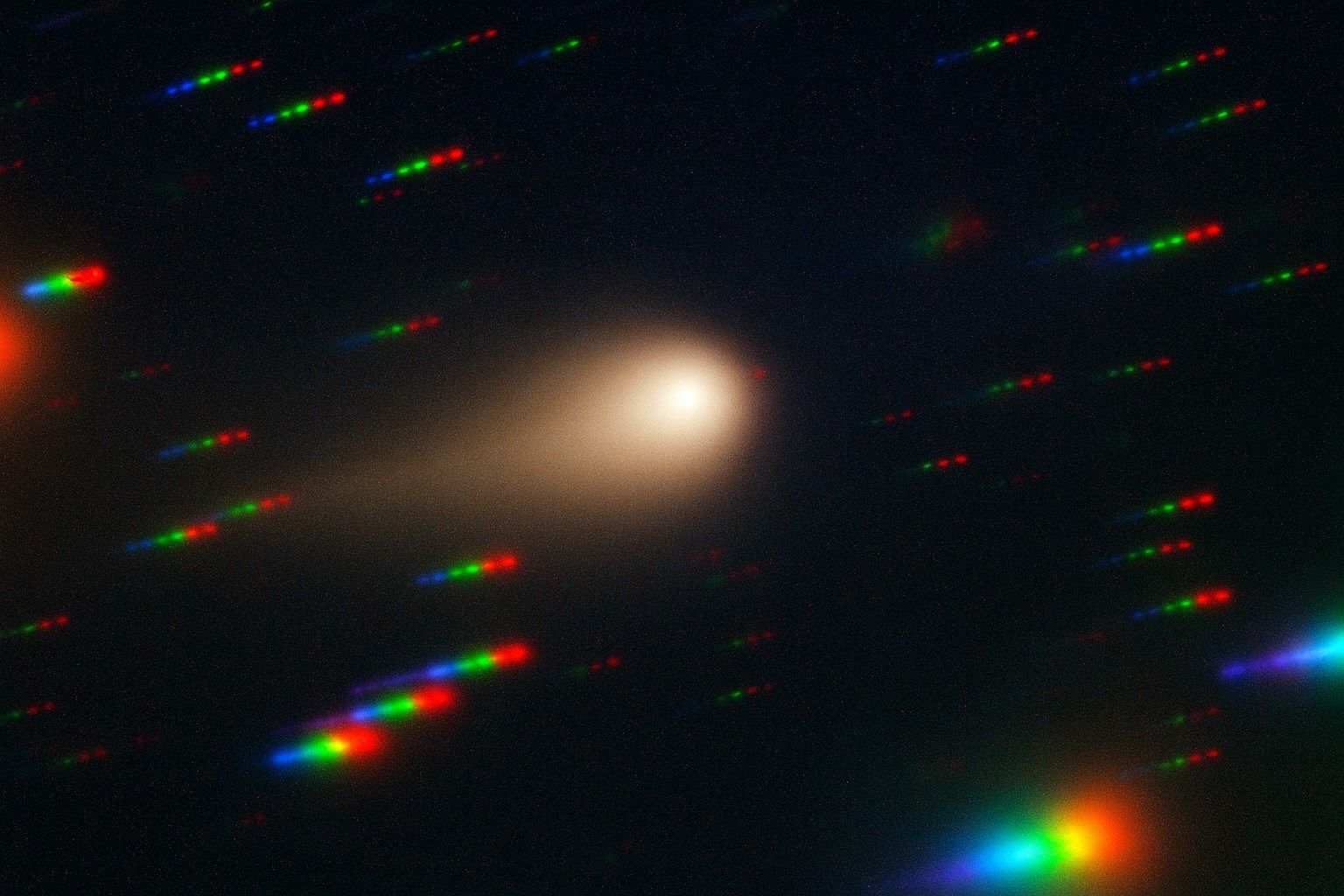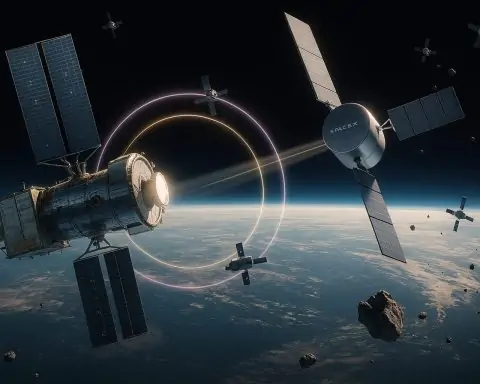- Rare Interstellar Visitor:Comet 3I/ATLAS was discovered on July 1, 2025, by the ATLAS survey in Chile and is only the third known object from beyond the solar system (after 1I/ʻOumuamua and 2I/Borisov) [1].
- No Threat to Earth: NASA confirmed this interstellar comet poses no danger – it will never come closer than about 240–270 million km from Earth (roughly 1.6–1.8 AU) [2] [3].
- Perihelion Surprises: At its closest approach to the Sun on Oct. 29, 2025 (perihelion), 3I/ATLAS brightened far more rapidly than expected, and even developed a distinct blue hue, baffling astronomers [4] [5].
- Scientific Goldmine: As an interstellar comet, 3I/ATLAS offers a unique peek into another star’s chemistry – scientists are excited to analyze its gas and dust to learn about the environment of its home system [6] [7].
- Old and Unusual: Researchers estimate 3I/ATLAS could be billions of years older than any solar system comet (possibly ~7–9 billion years old) [8] [9]. Its composition shows extraordinary traits (e.g. extremely high carbon dioxide levels and very low water content) unlike any comet seen before [10] [11].
- Observation Campaign: Telescopes and spacecraft across the Solar System – including Hubble, James Webb (JWST), solar observatories, and even Mars orbiters – have been tracking 3I/ATLAS. Ground-based astronomers will get another chance to observe it as it re-emerges from the Sun’s glare in mid-November 2025 [12] [13].
Discovery and Interstellar Identity
Comet 3I/ATLAS (officially Interstellar Comet 3I/ATLAS) was first spotted on July 1, 2025, by the NASA-funded ATLAS (Asteroid Terrestrial-impact Last Alert System) telescope in Río Hurtado, Chile [14]. Right away, its orbit stood out as hyperbolic, meaning it isn’t bound to the Sun by gravity and is just passing through. This identified 3I/ATLAS as an interstellar object – a rare visitor from another star system. It is only the third such interstellar traveler ever detected, after the mysterious cigar-shaped 1I/ʻOumuamua in 2017 and the comet 2I/Borisov in 2019 [15]. The “3I” designation literally means third interstellar, and “ATLAS” honors the discovery team [16].
Being such a rarity, 3I/ATLAS immediately sparked worldwide excitement among astronomers. “This is only the third such interstellar comet we’ve ever been able to study, and planetary scientists are super excited to learn about what comets in other solar systems are like,” said Jason Wright, an astronomer at Penn State [17]. Unlike ʻOumuamua – which was too small and fast for detailed study – 3I/ATLAS carries a visible halo of gas and dust (a coma and tail like a normal comet [18]). Its active outgassing makes it easier to observe and analyze, providing a unique scientific opportunity to sample material from another star’s planetary system [19].
Trajectory Through Our Solar System
3I/ATLAS zoomed into the solar system at extraordinary speed (over 130,000 mph or 210,000 km/h) from the direction of the galactic outskirts [20]. By early October 2025, it had already passed near Mars – coming within ~28 million km of the Red Planet on October 3 [21]. It reached perihelion (closest approach to the Sun) on October 29, 2025, at about 1.4 AU from the Sun (just inside Mars’s orbit) [22]. During this solar flyby, the comet was almost directly behind the Sun as seen from Earth, rendering it unobservable by most ground telescopes [23].
As 3I/ATLAS swung around the Sun, its path was sharply hyperbolic and unbound, confirming it will visit only once and then depart the solar system forever [24]. Its outbound leg will carry it back past the planetary orbits: after perihelion it began moving away from the Sun and Earth. The comet will make its closest approach to Earth on December 19, 2025, but even then it will remain a distant ~1.8 AU away (about 270 million km) [25]. It poses no impact risk, as NASA has stressed, staying roughly twice as far from us as the Sun is [26] [27].
Following the Earth flyby (at a safe distance), 3I/ATLAS is expected to pass near Jupiter in March 2026 (within about 50 million km of Jupiter on its way out) [28]. After that, it will head back into deep space, bound for the interstellar void. In short, 3I/ATLAS is just a fleeting guest in our neighborhood. Astronomers are making the most of its brief visit: as it recedes from the Sun’s glare in November and December 2025, the comet will become visible to telescopes again, offering a final window to observe this alien object [29] [30].
(Notably, the comet has been and will remain too faint for unaided eyes. At peak it only reached about magnitude 9 – requiring a decent amateur telescope to spot [31]. It was observed by powerful telescopes from July through early fall, then lost in sunlight near perihelion, and should be observable again in the Northern Hemisphere by December [32].)
An Unexpected Brightening at Perihelion
As with ordinary comets, scientists anticipated 3I/ATLAS would brighten as it neared the Sun – solar heat vaporizes its ices, releasing gas and dust that reflect more sunlight [33]. However, 3I/ATLAS astonished researchers by brightening at an extreme rate during the run-up to perihelion. Between mid-September and late October, its luminosity surged far faster than typical comets, defying predictions [34] [35]. The brightening followed an unusually steep trend (scaling as distance^(-7.5)), roughly double the rate expected [36] [37]. In practical terms, “3I/ATLAS brightened way faster than anticipated,” leaving experts puzzled as to why [38].
By perihelion on Oct. 29, the comet may have brightened to around magnitude 9, hundreds of times brighter than when first seen [39]. Yet the cause of this rapid outburst remains unclear. “The reason for 3I’s rapid brightening, which far exceeds the brightening rate of most Oort Cloud comets at similar distances, remains unclear,” wrote astronomers Qicheng Zhang and Karl Battams, who observed the event [40]. Normally, a comet’s activity ramps up smoothly as ices sublimate. In 3I/ATLAS’s case, some unusual mechanism or property must have triggered the extra boost in activity [41]. Researchers have proposed a few ideas: perhaps the comet’s high approach speed causes more violent outgassing, or maybe something about its nucleus composition or structure led to a sudden breakup of material [42]. “Oddities in nucleus properties like composition, shape, or structure — which might have been acquired from its host system or over its long interstellar journey — may likewise contribute to the rapid brightening,” Zhang and Battams noted [43].
The rapid flare-up suggests 3I/ATLAS might be shedding mass in bursts. Indeed, one astronomer calculated that it may have blown off a significant fraction of its mass (on the order of ~10%) during perihelion if gas jets caused the acceleration observed [44]. Correspondingly, telescopes are watching for any large dust/gas cloud emerging from the comet as it moves away [45]. Continued monitoring in November–December may reveal whether 3I/ATLAS’s brightness now fades quickly (if it exhausted a lot of material) or if it maintains an active coma for a while [46].
A Comet That Turned Blue?
Perhaps even more intriguing, 3I/ATLAS appears to have changed color as it rounded the Sun – a highly unusual behavior. Early in its approach, the comet’s coma was reported to have a reddish tint (likely from dust reflecting sunlight) [47] [48]. By September, some observers noted a green glow, typical for comets releasing cyanogen or diatomic carbon gas [49]. But after perihelion, scientists analyzing spacecraft data were surprised to find that 3I/ATLAS had developed a faint blue hue [50] [51]. Live Science reports this is the third time the comet’s apparent color shifted since discovery (red to green to blue) [52] [53]. Comets generally tend to become redder when near the Sun (as dust dominates); seeing a strong blue coloration is highly atypical [54].
The blue hue likely indicates the presence of specific glowing gases. According to researchers, the comet’s post-perihelion spectrum suggests emission from molecules like carbon monoxide (CO) or possibly ammonia, which shine blue, contributing significantly to its brightness [55] [56]. In fact, instruments on NASA’s solar-observing satellites (SOHO, STEREO, and GOES-19) managed to track 3I/ATLAS during its solar conjunction and found the comet’s light became “distinctly bluer than the Sun”, implying gas, not just dust, was dominating the coma’s glow [57] [58]. This was unexpected because earlier in its journey, the comet’s dust had made it appear reddish [59]. The sudden blue shift “came as a surprise” and wasn’t seen until now [60]. Scientists suspect that as 3I/ATLAS neared the Sun, different ices started vaporizing – for instance, CO or exotic volatiles that only sublimate at higher temperatures – releasing bluish-emitting gases into the coma [61] [62]. Notably, the comet’s water content seems low (as discussed below), so other gases could take over its emissions.
It’s worth noting that these color observations are preliminary (from a pre-print study) and still need confirmation from follow-up measurements [63]. If verified, 3I/ATLAS’s triple color change would be unprecedented, reflecting an evolving chemical mix. As one astronomer remarked, the comet’s color being “bluer than the Sun” is perplexing – ordinarily a cooler comet should appear redder, not bluer, than our hot Sun [64] [65]. The fact that blue overtook green and red in 3I/ATLAS’s coma underscores that something very unusual happened during its solar encounter. This adds another layer to the comet’s mystique, fueling both scientific curiosity and some wild speculation (more on that later).
Composition Clues: What’s Inside 3I/ATLAS?
Astronomers have been racing to decode the composition of 3I/ATLAS’s ices and dust – the key to understanding where it came from and how it formed. So far, results suggest this interstellar comet has a highly unusual makeup. Multiple observatories, including the James Webb Space Telescope (JWST) and the new SPHEREx space telescope, have detected a range of gases in 3I/ATLAS’s coma and made surprising discoveries:
- Carbon Dioxide-Rich Coma: Both JWST and SPHEREx found that 3I/ATLAS is enveloped in a “fog” of carbon dioxide (CO₂) gas [66] [67]. In fact, JWST measured the highest CO₂-to-water ratio ever seen in a comet [68]. Carbon dioxide, carbon monoxide, water vapor, and even some carbonyl sulfide were identified in the halo around the nucleus [69]. But remarkably, water vapor was relatively scarce compared to CO₂ [70] [71]. This indicates 3I/ATLAS’s core is intrinsically rich in CO₂ ice, or that water ice is not sublimating as readily as expected.
- “Dry” in Water, Loaded with CO₂: SPHEREx scientists noted an abundance of CO₂ gas around 3I/ATLAS, combined with evidence of water ice still locked in the nucleus [72] [73]. They intriguingly saw little to no carbon monoxide (CO) in the coma [74] [75]. Taken together, this suggests 3I/ATLAS lost much of its CO long ago, and even its water ice may be insulated or depleted, while CO₂ (which sublimates at intermediate temperatures) dominates its current activity [76] [77]. “SPHEREx’s finding of very large amounts of vaporized carbon dioxide gas around 3I/ATLAS told us it could be like a normal solar system comet,” said Carey Lisse of the SPHEREx team [78] – meaning it carries the same common ices, just in different proportions.
- Thermally Processed and Ancient: The compositional clues indicate 3I/ATLAS was likely “well baked and boiled” before leaving its original star system, according to Lisse [79]. In other words, it seems to have formed in an environment where it warmed enough to lose the most volatile ices (like CO) and even some water, retaining mainly less-volatile ices (CO₂, etc.) [80] [81]. This could happen if the comet either formed closer to its parent star than our typical Oort Cloud comets do, or if it spent billions of years in some warm region before being ejected [82] [83]. Lisse notes that a comet formed at the cold fringes of a young solar system should preserve all three major ices (water, CO₂, CO), whereas one that lingered in warmer zones will end up losing CO and be richer in water and CO₂ [84]. 3I/ATLAS fits the latter profile – it contains water and CO₂ but apparently lacks CO, implying it had been significantly warmed over time [85].
- Nickel and Other Oddities: Preliminary analyses have also found unexpected trace elements. For example, one report noted the gas plume of 3I/ATLAS contains much more nickel than iron, and an unusually high nickel-to-cyanide ratio, compared to typical comets [86]. The comet also exhibited “extreme negative polarization” (a certain optical property) rarely seen in other comets [87]. These hints suggest some differences in either the comet’s dust grains or chemistry that aren’t yet fully understood, further marking 3I/ATLAS as an outlier.
All these data points paint a picture of 3I/ATLAS as a very old, evolved comet from another star system. In fact, astronomers infer it may hail from the Milky Way’s thick disk – a population of ancient stars – based on its high speed and orbital angle. By examining its steep incoming trajectory, one team concluded 3I/ATLAS likely originated in a thick-disk star system and estimated it is “very likely to be the oldest comet we have ever seen,” on the order of 7–9 billion years old [88]. That’s almost twice the age of our solar system (4.6 billion years), meaning this comet could have formed around a star that predates the Sun by billions of years [89] [90]. If true, 3I/ATLAS carries pristine relic material from the early epochs of planet formation in our galaxy.
Scientists are thrilled at this chance to sample such ancient cosmic material. As JWST investigators explained, studying the chemistry of interstellar comets like this allows us to “study what conditions were like in those [other] systems as they were forming,” and compare it to the conditions of our own solar system’s birth [91]. The comet’s extreme CO₂ content, for example, might reveal that it formed near the CO₂ ice-line of its original protoplanetary disk – a specific zone around its star where temperatures were just right for CO₂ ice to form [92]. Alternatively, the composition could reflect exposure to higher radiation levels than typical comets get, hinting at a more intense stellar environment [93]. Every molecule detected (or not detected) in 3I/ATLAS’s coma is a clue to the chemical recipe and history of its home system.
A Coordinated Observation Campaign
Given 3I/ATLAS’s scientific importance, astronomers worldwide have mounted an extensive observation campaign. A broad array of instruments has been used to monitor the comet across different wavelengths:
- Optical Telescopes: The Hubble Space Telescope captured high-resolution images of 3I/ATLAS as early as July 2025, shortly after discovery [94]. Hubble provided some of the first detailed looks, resolving the comet’s growing coma and tail. Ground-based observatories (including amateur astronomers with large telescopes) also tracked the comet through the summer and early fall until it got too close to the Sun’s glare [95].
- James Webb Space Telescope: NASA’s new infrared powerhouse, JWST, turned its gaze on 3I/ATLAS on August 6, 2025 [96]. Using its NIRSpec spectrograph, JWST was able to detect and measure the comet’s key gases (CO₂, H₂O, CO, etc.) [97]. The unexpected CO₂ dominance discussed earlier was one of JWST’s big findings [98]. Webb’s exquisite sensitivity makes it ideal for analyzing faint interstellar material and will likely continue observing 3I/ATLAS as conditions allow, to track changes in the coma’s composition.
- Solar Observatory Spacecraft: Perhaps surprisingly, spacecraft designed to watch the Sun played a vital role during the comet’s perihelion. Researchers realized that satellites like NASA’s STEREO-A and STEREO-B, SOHO, and even NOAA’s GOES-19 (which has a solar coronagraph) could see 3I/ATLAS when Earth-based scopes could not [99] [100]. These probes captured the comet’s dramatic brightening and tail activity as it whipped around the Sun [101]. Images from GOES-19 even showed the comet as an extended object with a coma about 4 arcminutes across, confirming it was vigorously outgassing near perihelion [102].
- Mars Orbiters: In early October, when 3I/ATLAS passed near Mars, spacecraft at the Red Planet had a unique vantage. NASA’s Mars Reconnaissance Orbiter (MRO) took high-resolution snapshots of the comet on October 2, 2025, as it flew by Mars [103]. Some scientists (notably Harvard’s Avi Loeb) have urged NASA to release those images, anticipating they could provide valuable details on the comet’s nucleus and activity [104]. Additionally, Europe’s Mars Express orbiter reportedly observed the comet; European space agencies prepared their Mars spacecraft to be ready for 3I/ATLAS’s flyby [105].
- Jupiter Probe: As 3I/ATLAS heads out toward Jupiter’s orbit, even the Juno spacecraft at Jupiter might glean data. There was speculation that Juno could potentially detect charged particles or dust from the comet in 2026 if the geometry is right [106]. NASA noted this “once-in-a-lifetime opportunity” to possibly study an interstellar comet using existing planetary probes [107], although results remain to be seen.
In essence, the comet has been under an astronomical microscope. Nearly every tool available – from deep-space infrared telescopes to planetary orbiters – is being used to squeeze as much information as possible from this brief encounter. The coordination underscores how extraordinary 3I/ATLAS is; interstellar visitors are so rare that scientists are pulling out all the stops. “Continued observations may help provide a more definitive explanation for the comet’s behavior,” wrote Zhang and Battams, expressing hope that as 3I/ATLAS returns to darker skies, we’ll decode more of its mysteries [108].
Comparisons with ‘Oumuamua and Borisov
3I/ATLAS invites comparisons to its two cosmic predecessors, 1I/ʻOumuamua and 2I/Borisov, which were the first interstellar objects detected in our solar system. Each of these visitors has taught us different lessons, and 3I/ATLAS both follows and breaks patterns:
- 1I/ʻOumuamua (2017): The first interstellar object astonished astronomers with its oddities. ʻOumuamua was small (few hundred meters long), had no detectable coma or outgassing, and was identified only after it had already swung past the Sun. Its trajectory showed a slight non-gravitational acceleration (it sped up slightly, as if pushed by something), yet no gases were seen – sparking intense debate about its nature [109]. Some researchers speculated exotic explanations (from hydrogen ice to alien solar sails) for ʻOumuamua’s behavior. But with limited data (it was too dim and fast to study for long), ʻOumuamua largely remains an enigma. Importantly, 3I/ATLAS is much larger and brighter – in fact, its nucleus is estimated to be orders of magnitude bigger than ʻOumuamua’s [110] – and it clearly behaves like an active comet. This has allowed far more detailed observations. However, intriguingly, 3I/ATLAS might share one trait: possible non-gravitational motion. Like ʻOumuamua, it did not follow a perfect Keplerian orbit. In 3I/ATLAS’s case, though, the likely cause is robust outgassing (jets of vaporized ice acting like tiny thrusters). Even so, the strength of its deviation near perihelion surprised scientists, leading one team to note the comet was offset from its predicted path by a noticeable amount [111]. This outgassing push was “unusually strong” – but unlike ʻOumuamua, we have seen the material responsible (the comet blew out a huge amount of gas and dust) [112] [113].
- 2I/Borisov (2019): The second interstellar visitor – and until now, the only confirmed interstellar comet – was discovered in 2019 by amateur astronomer Gennady Borisov. 2I/Borisov looked much like a typical long-period comet: it had a visible coma and tail, and spectroscopic studies detected familiar substances like water vapor, cyanide, and carbon monoxide. One standout finding was that Borisov had an unusually high concentration of CO relative to water, suggesting it formed in a colder region or preserved more primordial ices [114] [115]. In general, though, Borisov’s behavior was not dramatically anomalous; it was often described as a “comet from another solar system that looks just like the comets from ours.” 3I/ATLAS, by contrast, is brighter and bigger (Newsweek notes it is about 1,000 times more massive than Borisov by some estimates) [116], and its compositional ratios (like CO₂ vs H₂O) are different from any comet observed. In essence, if Borisov showed that other star systems can produce comets akin to ours, 3I/ATLAS is showing that there is a diversity among interstellar comets – it comes from a perhaps older or chemically distinct star system, yielding a comet with far less water and more heavy volatiles. Both Borisov and 3I/ATLAS, however, reinforce the idea that comets regularly get ejected from their home systems; they might even be the most common type of interstellar object drifting in the galaxy [117] [118].
In summary, 1I/ʻOumuamua, 2I/Borisov, and 3I/ATLAS have each expanded our horizons. ʻOumuamua taught us that tiny, odd-shaped interstellar debris exists (and ignited conversations about what constitutes a comet vs asteroid, even extraterrestrial technology in wild conjectures). Borisov showed us a fairly “normal” comet from afar, hinting that building blocks of planets (like water-rich comets) are not unique to our solar system. Now, 3I/ATLAS is providing an unprecedented close-up on an interstellar comet’s behavior and composition, with surprises that challenge our understanding of comet physics. It sits somewhere between ʻOumuamua and Borisov – active like Borisov, but with some mysterious behaviors that evoke ʻOumuamua’s puzzles (albeit with actual gas jets to study).
Scientific Significance and What’s Next
The visit of 3I/ATLAS is a once-in-a-generation event for planetary science. With only three interstellar objects known so far, each one is precious. 3I/ATLAS’s significance lies in the wealth of data we can gather from it: its chemical fingerprint, its outgassing dynamics, and even how its surface reacts to solar heating. This comet provides a direct test of theories about comet formation in other planetary systems. Do distant stars form comets with similar compositions to ours? What might differences tell us about those stars’ environments? Already, 3I/ATLAS has hinted at answers – for instance, an extremely high CO₂ content might imply formation near a different kind of star or farther out in a colder protoplanetary disk than most of our comets [119]. Conversely, the lack of certain volatiles like CO suggests it underwent long-term warming, perhaps in a dense region of the galaxy where ambient starlight is stronger, or closer to its parent star before ejection [120].
Another exciting aspect is that interstellar objects could be common. Some astronomers have theorized that at any given time, there might be at least one interstellar object inside our solar system, just usually too faint to notice [121]. The discovery of 3I/ATLAS by an all-sky survey (ATLAS) underscores the value of automated telescopic surveys in catching these fast-moving visitors. Future surveys (like the Vera Rubin Observatory’s upcoming sky survey) are expected to detect many more interstellar intruders, perhaps even smaller ones. Each new sample will teach us more about the variety of planetesimals in our galaxy.
For now, scientists are eagerly awaiting more observations of 3I/ATLAS in its post-perihelion phase. As the comet moves into darker skies in mid/late November 2025, ground-based telescopes will resume scrutiny [122] [123]. They’ll be looking to see if the comet’s brightness plateaus or fades, which could indicate whether the nucleus survived intact or not after its violent outgassing episode [124]. If the comet remains active, astronomers will collect spectra to confirm the blue coma gases and monitor how the coma’s composition evolves as it cools. There is also interest in direct imaging of the nucleus if possible, to see its size and shape (Hubble and JWST may attempt this if the coma thins out). By the time 3I/ATLAS makes its nearest approach to Earth in December (albeit at 1.8 AU), we should have a clearer picture of its nature.
Additionally, the data from the various spacecraft (Mars orbiter images, JWST spectroscopy, etc.) will be studied for months and years to come. Already, papers are being published (and preprints posted) dissecting the findings [125] [126]. Every nuance – like the detection of a particular molecule or an unusual ratio of elements – can shed light on how planets and comets form around other stars.
No, It’s (Probably) Not Aliens
It’s worth addressing the elephant in the room that often comes up with interstellar objects: could it be artificial? Ever since ʻOumuamua’s strange behavior led a few to muse about alien probes, each new interstellar visitor faces that question. In the case of 3I/ATLAS, a few voices have noted its odd features and speculated fantastical explanations. The most prominent is Professor Avi Loeb of Harvard, who has suggested that the comet’s strong non-gravitational acceleration and unusual luminosity might hint at something non-natural (for example, he whimsically described the possibility of an “internal engine” driving it) [127]. However, the consensus among scientists is that 3I/ATLAS is behaving in line with a natural comet – just an especially dynamic one. The observed anomalies (surprising acceleration, color change, etc.) have plausible cometary explanations (outgassing jets, gas emission spectra) and don’t require invoking alien technology.
NASA itself has publically debunked the alien idea in response to public curiosity. When celebrity Kim Kardashian tweeted asking for “the tea on 3I/ATLAS,” NASA’s acting administrator replied to reassure everyone: “No aliens. No threat to life here on Earth.” [128]. In other words, 3I/ATLAS is fascinating, but it’s no alien spacecraft – it’s a natural iceball from a distant star, and it’s doing exactly what a comet does when it sunbathes: releasing gas in sometimes unpredictable ways. Moreover, unlike ʻOumuamua, we see a coma and tail, strongly indicating an icy object rather than an artificial one. The extravagant theories make for fun headlines, but so far all evidence points to Mother Nature as the culprit behind 3I/ATLAS’s weirdness.
Conclusion
As Comet 3I/ATLAS heads back toward the stars, it leaves astronomers with a trove of data and some big questions. In a span of mere months, this interstellar interloper has shown us a comet that brightens in a flash, changes colors like a chameleon, and carries chemical clues from the dawn of another solar system. Researchers around the world will be sifting through observations of 3I/ATLAS for years, comparing notes on its composition, dynamics, and what those reveal about its origin. Each new insight brings us one step closer to understanding the cosmic diversity of planetary systems – how nature’s building blocks might vary across the galaxy.
In the coming weeks, keep an eye out (with a telescope, if you have one!) as 3I/ATLAS becomes visible again in our night sky. Though faint, it represents something profound: a piece of a far-off world, temporarily visiting ours. The excitement it has stirred in the scientific community is summed up by the awe in experts’ voices. “This could be literally a once-in-a-lifetime opportunity,” one scientist said of the chance to study such an object [129]. Indeed, humanity may not see another interstellar comet for years or decades. 3I/ATLAS’s legacy will be the insights it yields – about the comet itself, about other star systems, and about the broader tapestry of our galaxy. As we bid it farewell later in 2026, 3I/ATLAS will carry fewer secrets than it brought in, thanks to the dedicated eyes and instruments trained on this messenger from the stars [130].
Sources:
- Space.com – “Interstellar invader Comet 3I/ATLAS is still full of surprises — an unexpected brightening has scientists baffled” [131] [132] [133] [134]
- Newsweek – “3I/ATLAS Live Updates: Comet’s Location from Earth, Scientists’ Theories” [135] [136] [137] [138]
- Live Science – “‘Interstellar visitor’ 3I/ATLAS may have just changed color — for the third time” [139] [140]
- ScienceAlert / Universe Today – “Interstellar Comet 3I/ATLAS’s Blue Shine Is Surprising Astronomers” [141] [142]
- Space.com – “The interstellar comet 3I/ATLAS is wrapped in carbon dioxide fog, NASA space telescope reveals” [143] [144]
- Space.com – “James Webb Space Telescope takes 1st look at interstellar comet 3I/ATLAS with unexpected results” [145] [146]
- Euronews – “Was 3I/ATLAS sent by aliens? Why the comet from another world continues to baffle” [147] [148]
- Others: NASA statements and expert commentary as cited above [149] [150].
References
1. www.newsweek.com, 2. www.newsweek.com, 3. www.newsweek.com, 4. www.space.com, 5. www.livescience.com, 6. www.space.com, 7. www.newsweek.com, 8. www.newsweek.com, 9. www.space.com, 10. www.space.com, 11. www.space.com, 12. www.space.com, 13. www.sciencealert.com, 14. www.newsweek.com, 15. www.space.com, 16. www.newsweek.com, 17. www.newsweek.com, 18. www.euronews.com, 19. www.space.com, 20. www.livescience.com, 21. www.newsweek.com, 22. www.livescience.com, 23. www.sciencealert.com, 24. www.newsweek.com, 25. www.newsweek.com, 26. www.newsweek.com, 27. www.newsweek.com, 28. www.newsweek.com, 29. www.sciencealert.com, 30. www.newsweek.com, 31. www.sciencealert.com, 32. www.newsweek.com, 33. www.space.com, 34. www.sciencealert.com, 35. www.sciencealert.com, 36. www.sciencealert.com, 37. www.sciencealert.com, 38. www.space.com, 39. www.sciencealert.com, 40. www.space.com, 41. www.space.com, 42. www.space.com, 43. www.space.com, 44. www.newsweek.com, 45. www.newsweek.com, 46. www.space.com, 47. www.newsweek.com, 48. www.euronews.com, 49. www.livescience.com, 50. www.livescience.com, 51. www.livescience.com, 52. www.livescience.com, 53. www.livescience.com, 54. www.euronews.com, 55. www.livescience.com, 56. www.sciencealert.com, 57. www.sciencealert.com, 58. www.livescience.com, 59. www.sciencealert.com, 60. www.livescience.com, 61. www.livescience.com, 62. www.sciencealert.com, 63. www.livescience.com, 64. www.newsweek.com, 65. www.newsweek.com, 66. www.space.com, 67. www.space.com, 68. www.space.com, 69. www.space.com, 70. www.space.com, 71. www.space.com, 72. www.space.com, 73. www.space.com, 74. www.space.com, 75. www.space.com, 76. www.space.com, 77. www.space.com, 78. www.space.com, 79. www.space.com, 80. www.space.com, 81. www.space.com, 82. www.space.com, 83. www.space.com, 84. www.space.com, 85. www.space.com, 86. www.newsweek.com, 87. www.newsweek.com, 88. www.space.com, 89. www.newsweek.com, 90. www.space.com, 91. www.space.com, 92. www.space.com, 93. www.space.com, 94. www.space.com, 95. www.newsweek.com, 96. www.space.com, 97. www.space.com, 98. www.space.com, 99. www.space.com, 100. www.sciencealert.com, 101. www.space.com, 102. www.sciencealert.com, 103. www.newsweek.com, 104. www.newsweek.com, 105. www.space.com, 106. www.space.com, 107. www.space.com, 108. www.space.com, 109. www.euronews.com, 110. www.newsweek.com, 111. www.euronews.com, 112. www.euronews.com, 113. www.euronews.com, 114. www.space.com, 115. www.space.com, 116. www.newsweek.com, 117. www.space.com, 118. www.space.com, 119. www.space.com, 120. www.space.com, 121. www.space.com, 122. www.space.com, 123. www.sciencealert.com, 124. www.space.com, 125. www.space.com, 126. www.space.com, 127. www.euronews.com, 128. www.euronews.com, 129. www.space.com, 130. www.space.com, 131. www.space.com, 132. www.space.com, 133. www.space.com, 134. www.space.com, 135. www.newsweek.com, 136. www.newsweek.com, 137. www.newsweek.com, 138. www.newsweek.com, 139. www.livescience.com, 140. www.livescience.com, 141. www.sciencealert.com, 142. www.sciencealert.com, 143. www.space.com, 144. www.space.com, 145. www.space.com, 146. www.space.com, 147. www.euronews.com, 148. www.euronews.com, 149. www.newsweek.com, 150. www.newsweek.com










